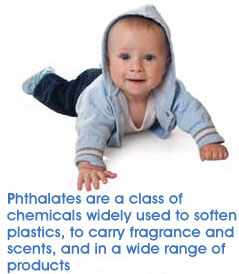Toxic phthalates continue to wreak hormone havoc. Birth defects of the penis. Undescended testicles leading to cancer. Decreased sperm count. Infertility.
This harm results when baby lab animals are exposed to a group of toxic chemicals known as phthalates (pronounced ‘thal-ates’). Phthalates interfere with the production of testosterone, the male hormone, during critical stages of fetal development. 
These same tragic health effects are on the rise in humans. And phthalate exposure to humans has been linked to changes in sex hormone levels and altered genital development. Pregnant women and babies are widely exposed to phthalates from everyday products used in our homes, offices and schools. Ninety percent of phthalates are used to soften vinyl plastic used in everything from shower curtains and inflatable toys to floor tiling and medical IV tubing.
For the last 35 years, chemical manufacturers have opposed every voluntary effort and proposed regulation intended to reduce human exposure to phthalates. These chemicals were among the 62,000 grandfathered in without mandatory health and safety testing or any restrictions on known hazards when the Toxic Substances Control Act (TSCA) was passed in 1976.
“Chemical manufacturers have opposed every voluntary effort and proposed regulation intended to reduce human exposure to phthalates.”
Weak federal law combined with aggressive industry lobbying has led to persistent exposure to phthalates. A new study shows that about 5% of children are exposed to unsafe levels of DEHP, the most dangerous phthalate, but 25% face dangerous exposure to all the phthalates combined. The National Academy of Sciences strongly recommends assessing the cumulative risks of groups of chemicals such as phthalates when each chemical poses similar health hazards.
Led by ExxonMobil Chemical Company, the largest U.S. manufacturer of phthalates, the chemical industry currently defends its profitable market by blocking regulations in every way it can.
For example, chemical manufacturers are attempting to undermine the recent Congressional ban on phthalates in children’s toys and childcare products. The Consumer Product Safety Improvement Act of 2008 banned three phthalates, and provisionally ended the use of three more pending further study. ExxonMobil Chemical wants to continue exposing children to DINP and DIDP, two high volume phthalates they make. They argue for excluding their chemicals from the cumulative risk assessment for phthalates.
“5% of children are exposed to unsafe levels of DEHP, the most dangerous phthalate…”
Also, thanks to the chemical industry, we’re now past Day 500 of the “chemicals of concern” hostage crisis. More than a year ago, the US EPA drafted a rule to simply list three groups of chemicals, including phthalates, as chemicals of concern under Section 5(b)(4) of TSCA. With the help of the Obama White House Office of Management and Budget, the industry has prevented the rule from being formally proposed for public review and comment. Given the very limited authority provided to EPA under the current TSCA, this modest rule, if ever adopted, would merely prioritize the chemical for consideration of possible future regulation and trigger export notice requirements. You can’t even think about regulating phthalates, according to industry gospel.
Lastly, the industry can’t even stomach voluntary efforts to promote safer alternatives to phthalates. They recently turned out in full force to challenge EPA’s alternatives assessment methods used in its Design for the Environment (DfE) project on phthalates. As an alternative to government regulation, DfE encourages voluntary stakeholder actions to reduce chemical risks through the use of safer chemicals and materials that are available and effective.
The chemical industry’s frontal assault in defense of phthalates ignores the writing on the wall. EPA has issued a Chemical Action Plan that names eight phthalates that should be considered priority chemicals. The European Chemicals Agency will consider a ban on four phthalates in all products intended for indoor use or which may directly contact the skin.
And about 80% of the American public across every demographic believe that we need stricter regulation of chemicals, such as phthalates, in order to better protect children’s health.
Through its ongoing phthalates exposure to children, and its opposition to proposed legislation to overhaul the badly broken TSCA, the chemical industry continues to place the health of our families in jeopardy.
Until the chemical industry negotiates for meaningful TSCA reform, through passage of the Safe Chemicals Act of 2011 for example, consumers must continue to take action into their own hands
Consumer Tips to Reduce Exposure to Phthalates
1. Look for product labels on plastic items and cosmetics that say phthalates-free. Some safer alternatives have entered the market already.
2. Avoid all soft vinyl products and packaging, since most products are unlabeled and 90% of phthalates are added as softeners to vinyl plastic. Contact CHEJ’s PVC Campaign to help drive phthalates from the market place.
3. Avoid vinyl floor tiles, wall coverings and other soft vinyl building materials. Contact the Healthy Building Network for safer alternatives.
4. Avoid vinyl office and school supplies. See CHEJ’s guide to PVC-free school options.
5. Ask your health care facility to invest in PVC-free medical supplies, including IV bags and tubing that expose pregnant women and children to phthalates. Contact Health Care Without Harm for more information.
6. Avoid phthalates used in nail polish, cosmetics and fragrances. Read the label and contact the Campaign for Safe Cosmetics for more information on safer products.



